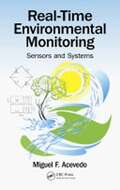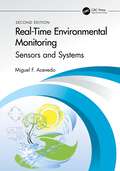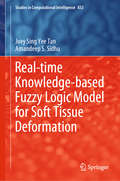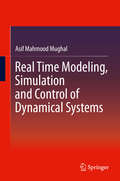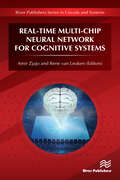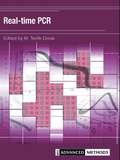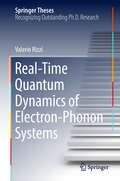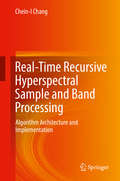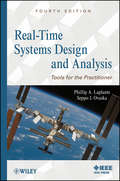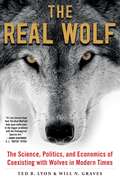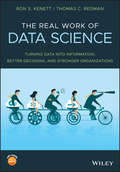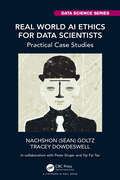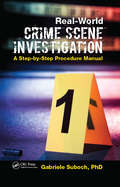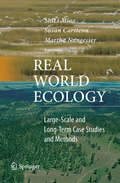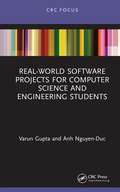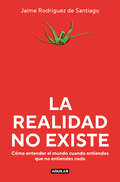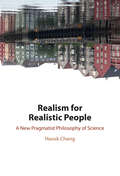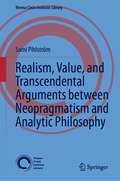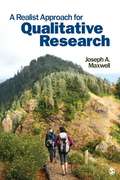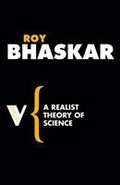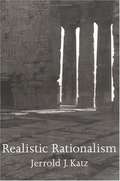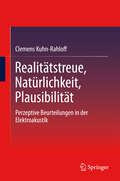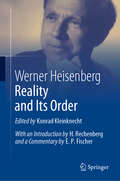- Table View
- List View
Real-Time Environmental Monitoring: Sensors and Systems
by Miguel F. AcevedoThe natural environment is complex and changes continuously at varying paces. Many, like the weather, we notice from day to day. However, patterns and rhythms examined over time give us the bigger picture. These weather statistics become climate and help us build an understanding of the patterns of change over the long term. <p><p> Real-Time Environmental Monitoring: Sensors and Systems introduces the fundamentals of environmental monitoring, based on electronic sensors, instruments, and systems that allow real-time and long-term data acquisition, data-logging, and telemetry. <p><p> The book details state-of-the-art technology, using a practical approach, and includes applications to many environmental and ecological systems. In the first part of the book, the author develops a story of how starting with sensors, you can progressively build more complex instruments, leading to entire systems that end with databases and web servers. In the second part, he covers a variety of sensors and systems employed to measure environmental variables in air, water, soils, vegetation canopies, and wildlife observation and tracking. <p><p> This is an emerging area that is very important to some aspects of environmental assessment and compliance monitoring. Real-time monitoring approaches can facilitate the cost effective collection of data over time and, to some extent, negate the need for sample, collection, handling, and transport to a laboratory, either on-site or off-site. It provides the tools you need to develop, employ, and maintain environmental monitors.
Real-Time Environmental Monitoring: Sensors and Systems - Textbook
by Miguel F. AcevedoWritten 10 years after the publication of the first edition, this updated edition of Real-Time Environmental Monitoring: Sensors and Systems introduces the fundamentals of environmental monitoring based on electronic sensors, instruments, systems, and software that allow continuous and long-term ecological and environmental data collection. It accomplishes two objectives: explains how to use sensors for building more complex instruments, systems, and databases, and introduces a variety of sensors and systems employed to measure environmental variables in air, water, soils, vegetation canopies, and wildlife observation and tracking. This second edition is thoroughly updated in every aspect of technology and data, and each theoretical chapter is taught parallel with a hands-on application lab manual. Emphasizes real-time monitoring as an emerging area for environmental assessment and compliance and covers the fundamentals on how to develop sensors and systems Presents several entirely new topics not featured in the first edition, including remote sensing and GIS, machine learning, weather radar and satellites, groundwater monitoring, spatial analysis, and habitat monitoring Includes applications to many environmental and ecological systems Uses a practical, hands-on approach with the addition of an accompanying lab manual, which students can use to deepen their understanding, based on the author’s 40 years of academic experience Intended for upper-level undergraduate and graduate students, taking courses in civil and environmental engineering, electrical engineering, mechanical engineering, geosciences, and environmental sciences, as well as professionals working in environmental services, and researchers and academics in engineering.
Real-time Knowledge-based Fuzzy Logic Model for Soft Tissue Deformation (Studies in Computational Intelligence #832)
by Joey Sing Tan Amandeep S. SidhuThis book provides a real-time and knowledge-based fuzzy logic model for soft tissue deformation. The demand for surgical simulation continues to grow, as there is a major bottleneck in surgical simulation designation and every patient is unique. Deformable models, the core of surgical simulation, play a crucial role in surgical simulation designation. Accordingly, this book (1) presents an improved mass spring model to simulate soft tissue deformation for surgery simulation; (2) ensures the accuracy of simulation by redesigning the underlying Mass Spring Model (MSM) for liver deformation, using three different fuzzy knowledge-based approaches to determine the parameters of the MSM; (3) demonstrates how data in Central Processing Unit (CPU) memory can be structured to allow coalescing according to a set of Graphical Processing Unit (GPU)-dependent alignment rules; and (4) implements heterogeneous parallel programming for the distribution of grid threats for Computer Unified Device Architecture (CUDA)-based GPU computing.
Real Time Modeling, Simulation and Control of Dynamical Systems
by Asif Mahmood MughalThis book introduces modeling and simulation of linear time invariant systems and demonstrates how these translate to systems engineering, mechatronics engineering, and biomedical engineering. It is organized into nine chapters that follow the lectures used for a one-semester course on this topic, making it appropriate for students as well as researchers. The author discusses state space modeling derived from two modeling techniques and the analysis of the system and usage of modeling in control systems design. It also contains a unique chapter on multidisciplinary energy systems with a special focus on bioengineering systems and expands upon how the bond graph augments research in biomedical and bio-mechatronics systems.
Real-Time Multi-Chip Neural Network for Cognitive Systems
by Amir Zjajo Rene Van LeukenSimulation of brain neurons in real-time using biophysically-meaningful models is a pre-requisite for comprehensive understanding of how neurons process information and communicate with each other, in effect efficiently complementing in-vivo experiments. In spiking neural networks (SNNs), propagated information is not just encoded by the firing rate of each neuron in the network, as in artificial neural networks (ANNs), but, in addition, by amplitude, spike-train patterns, and the transfer rate. The high level of realism of SNNs and more significant computational and analytic capabilities in comparison with ANNs, however, limit the size of the realized networks. Consequently, the main challenge in building complex and biophysically-accurate SNNs is largely posed by the high computational and data transfer demands.Real-Time Multi-Chip Neural Network for Cognitive Systems presents novel real-time, reconfigurable, multi-chip SNN system architecture based on localized communication, which effectively reduces the communication cost to a linear growth. The system use double floating-point arithmetic for the most biologically accurate cell behavior simulation, and is flexible enough to offer an easy implementation of various neuron network topologies, cell communication schemes, as well as models and kinds of cells. The system offers a high run-time configurability, which reduces the need for resynthesizing the system. In addition, the simulator features configurable on- and off-chip communication latencies as well as neuron calculation latencies. All parts of the system are generated automatically based on the neuron interconnection scheme in use. The simulator allows exploration of different system configurations, e.g. the interconnection scheme between the neurons, the intracellular concentration of different chemical compounds (ions), which affect how action potentials are initiated and propagate.
Real-time PCR (Advanced Methods)
by M. Tevfik DorakWith a variety of detection chemistries, an increasing number of platforms, multiple choices for analytical methods and the jargon emerging along with these developments, real-time PCR is facing the risk of becoming an intimidating method, especially for beginners. Real-time PCR provides the basics, explains how they are exploited to run a real-time PCR assay, how the assays are run and where these assays are informative in real life. It addresses the most practical aspects of the techniques with the emphasis on 'how to do it in the laboratory'. Keeping with the spirit of the Advanced Methods Series, most chapters provide an experimental protocol as an example of a specific assay.
Real-Time Quantum Dynamics of Electron–Phonon Systems (Springer Theses)
by Valerio RizziThis book develops a methodology for the real-time coupled quantum dynamics of electrons and phonons in nanostructures, both isolated structures and those open to an environment. It then applies this technique to both fundamental and practical problems that are relevant, in particular, to nanodevice physics, laser–matter interaction, and radiation damage in living tissue.The interaction between electrons and atomic vibrations (phonons) is an example of how a process at the heart of quantum dynamics can impact our everyday lives. This is e.g. how electrical current generates heat, making your toaster work. It is also a key process behind many crucial problems down to the atomic and molecular scale, such as the functionality of nanoscale electronic devices, the relaxation of photo-excited systems, the energetics of systems under irradiation, and thermoelectric effects. Electron–phonon interactions represent a difficult many-body problem. Fairly standard techniques are available for tackling cases in which one of the two subsystems can be treated as a steady-state bath for the other, but determining the simultaneous coupled dynamics of the two poses a real challenge. This book tackles precisely this problem.
Real-Time Recursive Hyperspectral Sample and Band Processing
by Chein-I ChangThis book explores recursive architectures in designing progressive hyperspectral imaging algorithms. In particular, it makes progressive imaging algorithms recursive by introducing the concept of Kalman filtering in algorithm design so that hyperspectral imagery can be processed not only progressively sample by sample or band by band but also recursively via recursive equations. This book can be considered a companion book of author's books, Real-Time Progressive Hyperspectral Image Processing, published by Springer in 2016.
Real-Time Structural Health Monitoring of Vibrating Systems
by Basuraj Bhowmik Budhaditya Hazra Vikram PakrashiTargeted at researchers and practitioners in the field of science and engineering, the book provides an introduction to real time structural health monitoring. Most work to date is based on algorithms that require windowing of the accumulated data, this work presents a coherent transition from the traditional batch mode practice to a recently developed array of recursive approaches. The book mainly focuses on the theoretical development and engineering applications of algorithms that are based on first order perturbation (FOP) techniques. The development of real time algorithms aimed at identifying the structural systems and the inflicted damage, online, through theoretical approaches paves the way for an in-depth understanding of the discussed topics. It then continues to demonstrate the solution to a class of inverse dynamic problems through numerically simulated systems. Extensive theoretical derivations supported by mathematical formulations, pivoted around the simple concepts of eigenspace updates, forms the key cornerstone of the book. The output response streaming in real time from multi degree of freedom systems provide key information about the system’s health that is subsequently utilized to identify the modal parameters and the damage, in real time. Damage indicators connotative of the nature, instant and location of damage, identified in a single framework are developed in the light of real time damage case studies. Backed by a comprehensive assortment of experimental test-beds, this book includes demonstrations to emulate real life damage scenarios under controlled laboratory conditions. Applicability of the proposed recursive methods towards practical problems demonstrate their robustness as viable candidates for real time structural health monitoring.
Real-Time Systems Design and Analysis: Tools for the Practitioner
by Phillip A. Laplante Seppo J. OvaskaThe leading text in the field explains step by step how to write software that responds in real time From power plants to medicine to avionics, the world increasingly depends on computer systems that can compute and respond to various excitations in real time. <P><P>The Fourth Edition of Real-Time Systems Design and Analysis gives software designers the knowledge and the tools needed to create real-time software using a holistic, systems-based approach. The text covers computer architecture and organization, operating systems, software engineering, programming languages, and compiler theory, all from the perspective of real-time systems design. The Fourth Edition of this renowned text brings it thoroughly up to date with the latest technological advances and applications. This fully updated edition includes coverage of the following concepts: Multidisciplinary design challenges Time-triggered architectures Architectural advancements Automatic code generation Peripheral interfacing Life-cycle processes The final chapter of the text offers an expert perspective on the future of real-time systems and their applications. The text is self-contained, enabling instructors and readers to focus on the material that is most important to their needs and interests. Suggestions for additional readings guide readers to more in-depth discussions on each individual topic. In addition, each chapter features exercises ranging from simple to challenging to help readers progressively build and fine-tune their ability to design their own real-time software programs. Now fully up to date with the latest technological advances and applications in the field, Real-Time Systems Design and Analysis remains the top choice for students and software engineers who want to design better and faster real-time systems at minimum cost.
The Real Wolf: The Science, Politics, and Economics of Coexisting with Wolves in Modern Times
by Ted B Lyon Will N. GravesThe Real Wolf is an in-depth study of the impact that wolves have had on big game and livestock populations as a federally protected species. Expert authors Ted B. Lyon and Will N. Graves, sift through the myths and misinformation surrounding wolves and present the facts about wolves in modern times. Each chapter in the book is meticulously researched and written by authors, biologists, geneticists, outdoor enthusiasts, and wildlife experts who have spent years studying wolves and wolf behavior. Every section describes a unique aspect of the wolf in the United States. The Real Wolf does not call for the eradication of wolves from the United States but rather advocates a new system of species management that would allow wolves, game animals, and farmers to coexist with one another in a way that is environmentally sustainable.Contributors to this groundbreaking environmental book include:Cat Urbigkit, award-winning wildlife author and photographerDr. Valerius Geist, foremost expert of big game in North AmericaMatthew Cronin, environmental researcher and geneticistRob Arnaud, president of Montana Outfitters and Guides Association
The Real Work of Data Science: Turning data into information, better decisions, and stronger organizations
by Ron S. Kenett Thomas C. RedmanThe essential guide for data scientists and for leaders who must get more from their data science teams The Economist boldly claims that data are now "the world's most valuable resource." But, as Kenett and Redman so richly describe, unlocking that value requires far more than technical excellence. The Real Work of Data Science explores understanding the problems, dealing with quality issues, building trust with decision makers, putting data science teams in the right organizational spots, and helping companies become data-driven. This is the work that spells the difference between a good data scientist and a great one, between a team that makes marginal contributions and one that drives the business, between a company that gains some value from its data and one in which data truly is "the most valuable resource." "These two authors are world-class experts on analytics, data management, and data quality; they've forgotten more about these topics than most of us will ever know. Their book is pragmatic, understandable, and focused on what really counts. If you want to do data science in any capacity, you need to read it."—Thomas H. Davenport, Distinguished Professor, Babson College and Fellow, MIT Initiative on the Digital Economy "I like your book. The chapters address problems that have faced statisticians for generations, updated to reflect today's issues, such as computational Big Data."—Sir David Cox, Warden of Nuffield College and Professor of Statistics, Oxford University "Data science is critical for competitiveness, for good government, for correct decisions. But what is data science? Kenett and Redman give, by far, the best introduction to the subject I have seen anywhere. They address the critical questions of formulating the right problem, collecting the right data, doing the right analyses, making the right decisions, and measuring the actual impact of the decisions. This book should become required reading in statistics and computer science departments, business schools, analytics institutes and, most importantly, by all business managers." —A. Blanton Godfrey, Joseph D. Moore Distinguished University Professor, Wilson College of Textiles, North Carolina State University
Real World AI Ethics for Data Scientists: Practical Case Studies (Chapman & Hall/CRC Data Science Series)
by Nachshon (Sean) Goltz Tracey DowdeswellIn the midst of the fourth industrial revolution, big data is weighed in gold, placing enormous power in the hands of data scientists – the modern AI alchemists. But great power comes with greater responsibility. This book seeks to shape, in a practical, diverse, and inclusive way, the ethical compass of those entrusted with big data. Being practical, this book provides seven real-world case studies dealing with big data abuse. These cases span a range of topics from the statistical manipulation of research in the Cornell food lab through the Facebook user data abuse done by Cambridge Analytica to the abuse of farm animals by AI in a chapter co-authored by renowned philosophers Peter Singer and Yip Fai Tse. Diverse and inclusive, given the global nature of this revolution, this book provides case-by-case commentary on the cases by scholars representing non-Western ethical approaches (Buddhist, Jewish, Indigenous, and African) as well as Western approaches (consequentialism, deontology, and virtue). We hope this book will be a lighthouse for those debating ethical dilemmas in this challenging and ever-evolving field.
Real-World Crime Scene Investigation: A Step-by-Step Procedure Manual
by Gabriele SubochReal-World Crime Scene Investigation: A Step-by-Step Procedure Manual is designed as a field guide providing instruction on how to document a crime scene, including sketching, mapping, searching, collecting, and preserving physical evidence. It also addresses how to document a crime scene using photography and videography. It introduces modern fore
Real World Ecology
by Susan Carstenn Martha Nungesser Shili MiaoEcological and environmental research has increased in scope and complexity in the last few decades, from simple systems with a few managed variables to complex ecosystems with many uncontrolled variables. These issues encompass problems that are inadequately addressed using the types of carefully controlled experiments that dominate past ecological research. Contemporary challenges facing ecologists include whole ecosystem responses to planned restoration activities and ecosystem modifications, as well as unplanned catastrophic events such as biological invasions, natural disasters, and global climate changes. Major perturbations implicated in large-scale ecological alterations share important characteristics that challenge traditional experimental design and statistical analyses. These include: * Lack of randomization, replication and independence * Multiple scales of spatial and temporal variability * Complex interactions and system feedbacks. In real world ecology, standard replicated designs are often neither practical nor feasible for large-scale experiments, yet ecologists continue to cling to these same standard designs and related statistical analyses. Case studies that fully elucidate the currently available techniques for conducting large-scale unreplicated analyses are lacking. Real World Ecology: Large-Scale and Long-Term Case Studies and Methods is the first to focus on case studies to demonstrate how ecologists can investigate complex contemporary problems using new and powerful experimental approaches. This collection of case studies showcases innovative experimental designs, analytical options, and interpretation possibilities currently available to theoretical and applied ecologists, practitioners, and biostatisticians. By illustrating how scientists have answered pressing questions about ecosystem restoration, impact and recovery, global warming, conservation, modeling, and biological invasions, this book will broaden the acceptance and application of modern approaches by scientists and encourage further methodological development.
Real-World Software Projects for Computer Science and Engineering Students
by Varun Gupta Anh Nguyen-DucDeveloping projects outside of a classroom setting can be intimidating for students and is not always a seamless process. Real-World Software Projects for Computer Science and Engineering Students is a quick, easy source for tackling such issues. Filling a critical gap in the research literature, the book: Is ideal for academic project supervisors. Helps researchers conduct interdisciplinary research. Guides computer science students on undertaking and implementing research-based projects This book explains how to develop highly complex, industry-specific projects touching on real-world complexities of software developments. It shows how to develop projects for students who have not yet had the chance to gain real-world experience, providing opportunity to become familiar with the skills needed to implement projects using standard development methodologies. The book is also a great source for teachers of undergraduate students in software engineering and computer science as it can help students prepare for the risk and uncertainty that is typical of software development in industrial settings.
La realidad no existe: Cómo entender el mundo cuando entiendes que no entiendes nada
by Jaime Rodríguez de SantiagoEl primer libro del creador del exitoso pódcast Kaizen. ¿Cuánto confías en lo que ves, sientes, piensas o recuerdas? ¿Y si fuera todo mentira? En este libro aprenderás que tu universo no es igual que el de tu perro ni que el del camarón mantis púrpura, que no ves el mar del mismo color que los griegos del siglo vii a.C., que tu pueblo es uno de los rincones más exóticos que existen, aunque no lo creas, o que puedes llegar a recordar cosas horribles que nunca sucedieron. Y es que la realidad en la que vivimos es muy frágil. Nos engañan los sentidos, el cerebro y la cultura; nos engañan hasta las leyes de la física. Pero, a pesar del vértigo que puede generarnos pensarlo, ser conscientes de nuestros filtros y nuestra percepción limitada de las cosas es el primer paso para empezar a entenderlas de verdad. Tras desarrollar BlaBlaCar en España y mientras dirige FreeNow en el sur y oeste de Europa, a Jaime Rodríguez de Santiago le ha dado tiempo de convertirse en un gran divulgador con su exitoso pódcast Kaizen. En estas páginas nos brinda la oportunidad de abrir nuestro foco y descubrir nuevos matices en todo lo que nos rodea, desmontando nuestras aparentes certezas y aportando herramientas y habilidades para construir nuestro mundo con una mirada distinta. Este libro cuenta que...•«Hay muchas cosas que existen, pero no forman parte de nuestra realidad y, a la vez, hay otras muchas que forman parte de nuestra realidad, pero no existen». •«Construimos nuestras explicaciones simplificando la realidad». •«Hay un conjunto de mecanismos psicológicos que nos empujan a no cambiar de opinión, hasta el punto de hacernos manipulables o, incluso, de reescribir nuestros recuerdos».•«La historia de la humanidad es la de una eterna búsqueda de sentido en la que tratamos de explicarnos las reglas del juego. Curiosamente, con cada paso que hemos dado, nos hemos alejado más y más de lo que al principio nos parecía obvio». •«Nos movemos por la vida tomando decisiones y actuando en virtud de lo que sabemos y, como mucho, con un ojo puesto en aquello de lo que somos conscientes que desconocemos. Pero hay una inmensidad que nos es tan completamente ajena que ni siquiera somos conscientes de que existe».
Realism for Realistic People: A New Pragmatist Philosophy of Science
by Hasok ChangIn this innovative book, Hasok Chang constructs a philosophy of science for 'realistic people' interested in understanding and promoting the actual practices of inquiry in science and other knowledge-focused areas of life. Inspired by pragmatist philosophy, he reconceives the very notions of reality and truth on the basis of his concept of the 'operational coherence' of epistemic activities, and offers new pragmatist conceptions of truth and reality as operational ideals achievable in actual scientific practice. Rejecting the version of scientific realism that is concerned with claiming that our theories correspond to an ultimate reality, he proposes instead an 'activist realism': a commitment to do all that we can actually do to improve our knowledge of realities. His book will appeal to scholars and students in philosophy, science and the history of science, and all who are concerned about the place of science and empirical truth in society.
Realism, Value, and Transcendental Arguments between Neopragmatism and Analytic Philosophy (Vienna Circle Institute Library #7)
by Sami PihlströmThe essays collected in this volume and authored by Sami Pihlström emphasize that our relation to the world we live in and seek to represent and get to know better through our practices of conceptualization and inquiry is irreducibly valuational. There is no way of even approaching, let alone resolving, the philosophical issue of realism without drawing due attention to the ways in which human values are inextricably entangled with even the most purely “factual” projects of inquiry we engage in.This entanglement of the factual and the normative is, as explicitly argued in Chapter 7 but implicitly suggested in all the other chapters as well, both pragmatic (practice-embedded and practice-involving) and transcendental (operating at the level of the necessary conditions for the possibility of our representing and cognizing the world in general). The author claims we need to carefully examine the complex relations of realism, value, and transcendental arguments at the intersection of pragmatism and analytic philosophy. This book does so by offering case-studies of various important neopragmatists and philosophers close to the pragmatist tradition, including Hilary Putnam, Nicholas Rescher, Joseph Margolis, and Ludwig Wittgenstein. It appeals to scholars and advanced graduate students focusing on pragmatism and analytic philosophy.
A Realist Approach For Qualitative Research
by Joseph A. MaxwellThis ground-breaking book makes the case for adopting a realist philosophical perspective for qualitative research. Joseph Maxwell argues for critically applying a realist ontology to a number of important theoretical and methodological issues. This can provide a stronger justification for what qualitative researchers do, he contends, and significantly contribute to current theories and practices. The book outlines critical realism and considers its implications for how we conceptualize meaning and culture, causation, and diversity. The author applies critical realist ideas and approaches to the design and methods of qualitative research, and presents two in-depth case studies of projects he conducted, describing how realist (and other) perspectives informed the research, the methods, and the conclusions.
A Realist Theory of Science (Radical Thinkers)
by Roy Bhaskar<i>A Realist Theory of Science</i> is one of the few books that have changed our understanding of the philosophy of science. In this analysis of the natural sciences, with a particular focus on the experimental process itself, Roy Bhaskar provides a definitive critique of the traditional, positivist conception of science and stakes out an alternative, realist position. Since it original publication in 1975, a movement known as ‘Critical Realism’, which is both intellectually diverse and international in scope, has developed on the basis of key concepts outlined in the text. The book has been hailed in many quarters as a ‘Copernican Revolution’ in the study of the nature of science, and the implications of its account have been far-reaching for many fields of the humanities and social sciences.
The realistic empiricism of Mach, James, and Russell
by Erik C. BanksIn the early twentieth century, Ernst Mach, William James, and Bertrand Russell founded a philosophical and scientific movement known as 'neutral monism', based on the view that minds and physical objects are constructed out of elements or events which are neither mental nor physical, but neutral between the two. This movement offers a unified scientific outlook which includes sensations in human experience and events in the world of physics under one roof. In this book Erik C. Banks discusses this important movement as a whole for the first time. He explores the ways in which the three philosophers can be connected, and applies their ideas to contemporary problems in the philosophy of mind and the philosophy of science - in particular the relation of sensations to brain processes, and the problem of constructing extended bodies in space and time from particular events and causal relations.
Realistic Rationalism
by Jerrold J. KatzJerrold J. Katz develops a new philosophical position integrating realism and rationalism. Realism here means that the objects of study in mathematics and other formal sciences are abstract; rationalism means that our knowledge of them is not empirical.
Realitätstreue, Natürlichkeit, Plausibilität
by Clemens Kuhn-RahloffDieses Buch richtet sich an Ingenieure und Forscher im Bereich der Kommunikationsakustik und anderen Gebieten der Wahrnehmungsforschung. Es bewegt sich im interdisziplinären Feld von Kommunikationsakustik, Informationstheorie und Wahrnehmungspsychologie und liefert einen wesentlichen Beitrag zum Verständnis der akustischen Wahrnehmung. Im Zentrum steht dabei der Begriff der Plausibilität als grundlegender Bestandteil kommunikationsakustischer Technik. Um Eigenschaften von Plausibilitätsurteilen bei der akustischen Wahrnehmung zu von Menschen zu erörtern, stellt das Buch ausgewählte top-down-Prozesse der Wahrnehmung in den Vordergrund, die das Urteilsverhalten beeinflussen. Plausibilität wird im Kontext existierender Modelle für perzeptive Messungen dargestellt und die Anforderungen werden diskutiert, die an den Begriff gestellt werden, wenn er im psychoakustischen Sinn als Messgröße aufgefasst wird.
Reality and Its Order
by Werner HeisenbergAvailable here for the first time in English, "Reality and Its Order" is a remarkable philosophical text by Werner Heisenberg, the father of quantum mechanics and one of the leading scientists of the 20th century. Written during the wartime years and initially distributed only to his family and trusted friends, the essay describes Heisenberg’s philosophical view of how we understand the natural world and our role within it. In this volume, the essay is introduced by the physicist Helmut Rechenberg and annotated by the science historian Ernst Peter Fischer. The content, particularly within its historical context, will be of great interest to many physicists, philosophers and historians of science.
